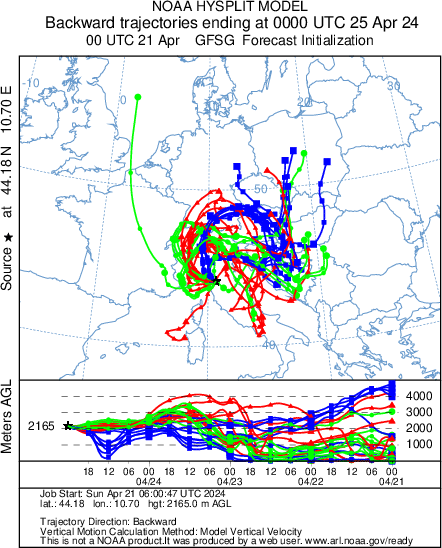Aerosol number concentration
Starting date: 19-3-2008
Status: Running
Instrumentation and calibration: The Condensation Particle Counter (TSI model 3772) was installed at ICO-OV in March 2008, calibrated from TSI Laboratories. Once per year the instrument is used for a multi-ay intercomparison with the CPC running at the "Nepal Climate Observatory - Pyramid" GAW global station . The CPC 3772 detects airborne particles with diameter ranging from 10 nm (counting efficiency > 50%) to 3 µm at an aerosol flow rate of 1.0 l/min, over a concentration range from 0 to 104 particles/cm3. The aerosol sample passing through a heated saturator in which butanol is vaporized, then the aerosol sample and alcohol vapour pass into a cooled condenser where the alcohol vapour be comes supersaturated and ready to condense. Particles present in the sample stream serve as condensation nuclei. Once condensation begins, particles that are larger than a threshold diameter grow quickly into larger drop lets and pass through an optical detector where they are counted easily. According to the manufacturer the particle concentration accuracy is ±10%.
Project affiliation (s) Present: SHARE, EUSAAR, GAW-WMO
Related research programmes
- Tropospheric background condition
- Polluted air-mass transport
- Aerosol properties
Why is this research important? Aerosol particles are ubiquitous in the atmosphere. They exert significant effects on the Earth’s climate. First, they absorb and scatter incoming solar radiation (direct radiative forcing). Second, they act as cloud condensation nuclei (CCN), influencing the cloud microphysical and optical properties as well as their life-time and precipitation (indirect effect). Due to the high variability of the natural as well as the anthropogenic aerosol in the troposphere, the corresponding radiative effects vary highly in time and space. The latest report from IPCC has shown that atmospheric aerosols represent the largest uncertainty in understanding and giving future predictions of the Earth’s climate. Aerosol number concentration varies greatly in both, time and space. Meanwhile, the existing in-situ aerosol observation system is patchy with respect to global coverage, very little information are available especially remote environment and in free troposphere.
Quick look The seasonal aerosol number number distribution showed a behaviour typical for background conditions, characterized by highest values in summer (2430 ± 1198 cm-3)and lowest in winter (1050 ± 737 cm-3). Neverthless the total particle number show a highest variability with respect to accumulatiojn fraction (measured by OPC) due to occurrence of new particle formation events. Except in winter, the fine particle showed a clear diurnal variation with high values during day-time.
Organization (s): ISAC-CNR Via Gobetti 101, I-40129, Bologna www.isac.cnr.it
Contact persons: Dr. Angela Marinoni e-mail: a.marnoni [at] isac.cnr.it phone: +39 051 6399597
Where can I find the data? EBAS - World Data Centre for Aerosol (WDCA) or by direct request to:a.marinoni [at] isac.cnr.it



